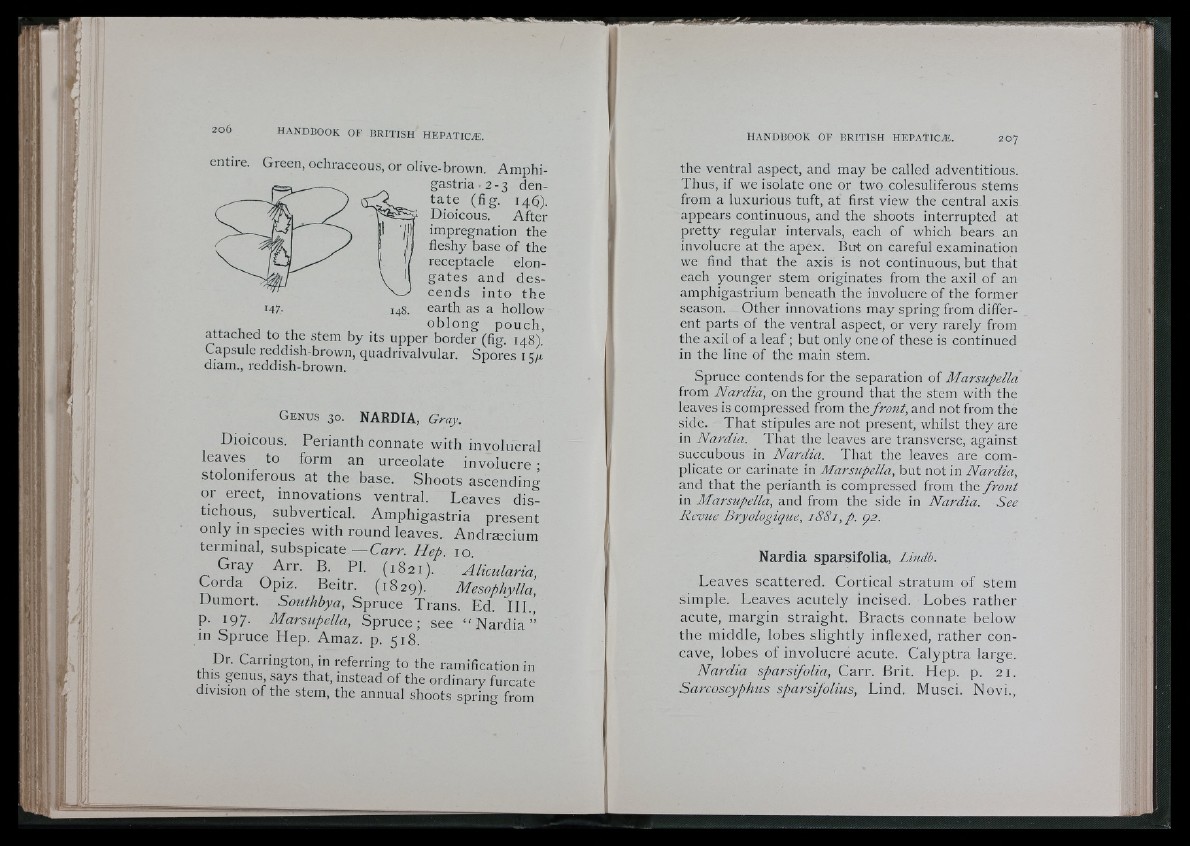
2 o 6
entire. Green, ochraceous, or olive-brown. Amphigastria.
2-3 denta
te (fig. 14^).
Dioicous. After
impregnation the
fleshy base of the
receptacle elong
a t e s and de s c
ends into the
earth as a hollow
XX 1 , , o b lo n g pouch,
attached to the stem by its upper border (fig. 148).
Capsule reddish-brown, quadrivalvular. Spores i
diam., reddish-brown.
G en u s 30. NARDIA, Gray.
Dioicous. Perianth connate with involucral
leaves to form an urceolate involucre •
stoloniferous at the base. Shoots ascendin¿
or erect, innovations ventral. Le a v e s distichous,
subvertical. Amp h ig a s t r ia present
only in species with round leaves. Andrgecium
terminal, subspicate — Carr. Hep 10
G r a y A r r . B. PI. ( 1821 ) . Alicularia,
Corda Opiz. Beitr. (1829). Mesophylla,
Dumort. Southbya, Spruce Trans . Ed. III.,
p. 197. Marsupella, S p ru c e ; see “ N a r d i a ”
in Spruce Hep. Ama z . p. 518.
Dr. Carrington, in referring to the ramification in
this genus says that, instead of the ordinary furcate
division of the stem, the annual shoots spring from
the ventral aspect, and may be called adventitious.
Thus, if we isolate one or two colesuliferous stems
from a luxurious tuft, at first view the central axis
appears continuous, and the shoots interrupted at
pretty regular intervals, each of which bears an
involucre at the apex. But on careful examination
we find that the axis is not continuous, but that
each younger stem originates from the axil of an
amphigastrium beneath the involucre of the former
season. Other innovations may spring from different
parts of the ventral aspect, or very rarely from
the axil of a le a f ; but only one of these is continued
in the line of the main stem.
Spruce contends for the separation of Marsupella
from Nardia, on the ground that the stem with the
leaves is compressed from the front, and not from the
side. That stipules are not present, whilst they are
in Nardia. That the leaves are transverse, against
succubous in Nardia. That the leaves are complicate
or carinate in Marsupella, but not in Nardia,
and that the perianth is compressed from the front
in Marsupella, and from the side in Nardia. See
Revue Bryologique, i8 8 i,p . 92.
Nardia sparsifolia, Lindb.
Le a v e s scattered. Cort ical stratum of stem
simple. Leav e s acutely incised. Lobe s rather
acute, margin straight. Bracts connate below
the middle, lobes s l ight ly inflexed, rather concave,
lobes of involucre acute. Ca lyptra large.
Nardia sparsifolia, Carr. Brit. Hep. p. 21.
Sarcoscyphus sparsifolius, Lind. Musci. Novi.,